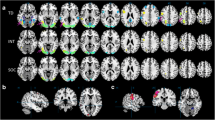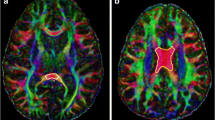Abstract
Children treated with cranial irradiation for brain tumors have reduced white matter volume and deficits in reading ability. This study prospectively examined the relationship between reading and white matter integrity within this patient group. Patients (n = 54) were treated with post-surgical radiation followed by 4 cycles of high-dose chemotherapy with stem cell support. At 12 months post-diagnosis, all patients completed a neuropsychology evaluation and a diffusion tensor imaging (DTI) exam. White matter integrity was determined through measures of fractional anisotropy (FA). Significant group differences in FA were found between above average readers and below average readers within the left and right posterior limb of the internal capsule, and right knee of the internal capsule with a trend within the left temporaloccipital region. The integrity of the white matter in these regions may affect communication among visual, auditory, and language cortical areas that are engaged during reading.



Similar content being viewed by others
References
Alexander, A. L., Tsuruda, J. S., & Parker, D. L. (1997). Elimination of eddy current artifacts in diffusion-weighted echo-planar images: the use of bipolar gradients. Magnetix Resonance in Medicine, 38(6), 1016–1021.
Barkovitch, A. J. (2000). Concepts of myelin and myelination in neuroradiology. American Journal of Neuroradiology, 21, 1099–1109.
Basser, P. J., & Jones, D. K. (2002). Diffusion-tensor MRI: theory, experimental design and data analysis - a technical review. NMR in Biomedicine, 15(7–8), 456–467.
Beaulieu, C., Plewes, C., Paulson, L. A., Roy, D., Snook, L., Concha, L., et al. (2005). Imaging brain connectivity in children with diverse reading ability. NeuroImage, 25(4), 1266–1271.
Ben-Shachar, M., Dougherty, R. F., & Wandell, B. A. (2007). White matter pathways in reading. Current Opinion in Neurobiology, 17(2), 258–270.
Briere, M., Scott, J. G., McNall-Knapp, R. Y., & Adams, R. L. (2008). Cognitive outcome in pediatric brain tumor survivors: delayed attention deficit at long term follow-up. Pediatric Blood Cancer, 50, 337–340.
Ciccarelli, O., Werring, D. J., Wheeler-Kingshott, C. A., Barker, G. J., Parker, G. J., Thompson, A. J., et al. (2001). Investigation of MS normal-appearing brain using diffusion tensor MRI with clinical correlations. Neurology, 56(7), 926–933.
Deutsch, G. K., Dougherty, R. F., Bammer, R., Siok, W. T., Gabrieli, J. D., & Wandell, B. (2005). Children’s reading performance is correlated with white matter structure measured by diffusion tensor imaging. Cortex, 41(3), 354–363.
Genovese, C. R., Lazar, N. A., & Nichols, T. (2002). Thresholding of statistical maps in functional neuroimaging using the false discovery rate. NeuroImage, 15(4), 870–878.
Khong, P. L., Kwong, D. L., Chan, G. C., Sham, J. S., Chan, F. L., & Ooi, G. C. (2003). Diffusion-tensor imaging for the detection and quantification of treatment-induced white matter injury in children with medulloblastoma: a pilot study. American Journal of Neuroradiology, 24(4), 734–740.
Khong, P. L., Leung, L. H. T., Fung, A. S. M., Fong, D. Y. T., Qiu, D., Kwong, D. L., et al. (2006). White matter anisotropy in post-treatment childhood cancer survivors: preliminary evidence of association with neurocognitive function. Journal of Clinical Oncology, 24(6), 884–890.
Kieffer-Renaux, V., Bulteau, C., Grill, J., Kalifa, C., Viguier, D., & Jambaque, I. (2000). Patterns of neuropsychological deficits in children with medulloblastoma according to craniospatial irradiation doses. Developmental Medicine and Child Neurology, 42, 741–745.
Klingberg, T., Vaidya, C. J., Gabrieli, J. D., Moseley, M. E., & Hedehus, M. (1999). Myelination and organization of the frontal white matter in children: a diffusion tensor MRI study. Neuroreport, 10(13), 2817–2821.
Klingberg, T., Hedehus, M., Temple, E., Salz, T., Gabrieli, J. D., Moseley, M. E., et al. (2000). Microstructure of temporo-paretal white matter as a basis for reading disability: evidence from diffusion tensor magnetic resonance imaging. Neuron, 25, 493–500.
Leung, L. H. T., Ooi, G. C., Kwong, D. L., Chan, G. C. F., Cao, G., & Khong, P. L. (2004). White matter diffusion anisotropy after chemo-irradiation: a statistical parametric mapping study and histogram analysis. NeuroImage, 21, 261–268.
Louis, D. N., Ohgaki, H., Wiestler, O. D., Cavenee, W. K., Burger, P. C., Jouvet, A., et al. (2007). The 2007 WHO classification of tumours of the central nervous system. Acta Neuropathologica, 114(2), 97–109.
Mabbott, D. J., Spiegler, B. J., Greenberg, M. L., Rutka, J. T., Hyder, D. J., & Bouffet, E. (2005). Serial evaluation of academic and behavioral outcome after treatment with cranial radiation in childhood. Journal of Clinical Oncology, 23(10), 2256–2263.
Mabbott, D. J., Noseworthy, M. D., Bouffet, E., Rockel, C., & Laughlin, S. (2006). Diffusion tensor imaging of white matter after cranial radiation in children for medulloblastoma: correlation with IQ. Neuro Oncology, 8, 244–252.
Mabbott, D. J., Penkman, L., Witol, A., Strother, D., & Bouffet, E. (2008). Core neurocognitive functions in children treated for posterior fossa tumors. Neuropsychology, 22(2), 159–168.
Mulhern, R. K., Palmer, S. L., Merchant, T. E., Wallace, D., Kocak, M., Brouwers, P., et al. (2005). Neurocognitive consequences of risk-adapted therapy for childhood medulloblastoma. Journal of Clinical Oncology, 23(24), 5511–5519.
Nagel, B. J., Delis, D. C., Palmer, S. L., Reeves, C., Gajjar, A., & Mulhern, R. K. (2006). Early patterns of verbal memory impairment in children treated for medulloblastoma. Neuropsychology, 20(1), 105–112.
Nagy, Z., Westerberg, H., & Klingberg, T. (2004). Maturation of white matter is associated with the development of cognitive functions during childhood. Journal of Cognitive Neuroscience, 16(7), 1227–1233.
Oeffinger, K. C., Mertens, A. C., Sklar, C. A., Kawashima, T., Hudson, M. M., Meadows, A. T., et al. (2006). Chronic health conditions in adult survivors of childhood cancer. New England Journal of Med, 355(15), 1572–1582.
Oldfield, F. C. (1971). The assessment and analysis of handedness: the Edinburgh Inventory. Neuropsychologia, 9, 97–113.
Palmer, S. L., Gajjar, A., Reddick, W. E., Glass, J. O., Kun, L. E., Wu, S., et al. (2003). Predicting intellectual outcome among children treated with 35–40 Gy craniospinal irradiation for medulloblastoma. Neuropsychology, 17(4), 548–555.
Pugh, K. R., Mencl, W. E., Jenner, A. R., Katz, L., Frost, S. J., Lee, J. R., et al. (2001). Neurobiological studies of reading and reading disability. Journal of Communication Disorders, 34(6), 479–492.
Qiu, D., Tan, L. H., Zhou, K., & Khong, P. L. (2008). Diffusion tensor imaging of normal white matter maturation from late childhood to young adulthood: voxel-wise evaluation of mean diffusivity, fractional anisotropy, radial and axial diffusivities, and correlation with reading development. NeuroImage, 41(2), 223–232.
Rauschecker, A. M., Deutsch, G. K., Ben-Shachar, M., Schwartzman, A., Perry, L. M., & Dougherty, R. F. (2009). Reading impairment in a patient with missing arcuate fasciculus. Neuropsychologia, 47(1), 180–194.
Reese, T. G., Heid, O., Weisskoff, R. M., & Wedeen, V. J. (2003). Reduction of eddy-current-induced distortion in diffusion MRI using a twice-refocused spin echo. Magnetic Resonance in Medicine, 49(1), 177–182.
Reeves, C. B., Palmer, S. L., Reddick, W. E., Merchant, T. E., Buchanan, G. M., Gajjar, A., et al. (2006). Attention and memory functioning among pediatric patients with medulloblastoma. Journal of Pediatric Psychology, 31(3), 272–280.
Ries, L., Smith, M., Gurney, J., Linet, M., Tamra, T., Young, J., et al. (Eds.). (1999). Cancer Incidence and Survival among Children and Adolescents: United States SEER Program 1975–1995 (Vol. NIH Pub. No. 99-4649). Bethesda, MD: National Cancer Institute, SEER Program.
Rueckert, D., Frangi, A. F., & Schnabel, J. A. (2003). Automatic construction of 3-D statistical deformation models of the brain using nonrigid registration. IEEE Transactions on Medical Imaging, 22(8), 1014–1025.
Shaywitz, S. E., & Shaywitz, B. A. (2003). Dyslexia (specific reading disability). Pediatrics in Review, 24(5), 147–153.
Shaywitz, S. E., & Shaywitz, B. A. (2005). Dyslexia (specific reading disability). Biological Psychiatry, 57(11), 1301–1309.
Shaywitz, S. E., Shaywitz, B. A., Fulbright, R. K., Skudlarski, P., Mencl, W. E., Constable, R. T., et al. (2003). Neural systems for compensation and persistence: young adult outcome of childhood reading disability. Biological Psychiatry, 54(1), 25–33.
Shaywitz, B. A., Lyon, G. R., & Shaywitz, S. E. (2006). The role of functional magnetic resonance imaging in understanding reading and dyslexia. Developmental Neuropsychology, 30(1), 613–632.
Shaywitz, B. A., Skudlarski, P., Holahan, J. M., Marchione, K. E., Constable, R. T., Fulbright, R. K., et al. (2007). Age-related changes in reading systems of dyslexic children. Annals of Neurology, 61(4), 363–370.
Snook, L., Plewes, C., Beaulieu, C. (2007). Voxel based versus region of interest analysis in diffusion tensor imaging of neurodevelopment. Neuroimage, 34, 243–252.
Temple, E., Deutsch, G. K., Poldrack, R. A., Miller, S. L., Tallal, P., Merzenich, M. M., et al. (2003). Neural deficits in children with dyslexia ameliorated by behavioral remediation: evidence from functional MRI. Proceedings of the National Academy of Sciences of the Uited States of America, 100(5), 2860–2865.
Woodcock, R., McGraw, K., & Mather, N. (2001). Woodcock-Johnson third edition, tests of achievement. Itasca: Riverside.
Zhang, Y., Zou, P., Mulhern, R. K., Butler, R. W., Laningham, F. H., & Ogg, R. J. (2008). Brain structural abnormalities in survivors of pediatric posterior fossa brain tumors: a voxel-based morphometry study using free-form deformation. NeuroImage, 42(1), 218–229.
Acknowledgements
This work was supported in part by Cancer Center Support (CORE) grant P30CA21765, R01 CA78957, R01CA90246, R01HD49888 and U01CA81445 from the National Cancer Institute and by the American Lebanese Syrian Associated Charities (ALSAC).
Author information
Authors and Affiliations
Corresponding author
Additional information
This work was presented in part as an abstract at the 13th International Symposium on Pediatric Neuro-Oncology, July 2, 2008, Chicago, IL.
Rights and permissions
About this article
Cite this article
Palmer, S.L., Reddick, W.E., Glass, J.O. et al. Regional White Matter Anisotropy and Reading Ability in Patients Treated for Pediatric Embryonal Tumors. Brain Imaging and Behavior 4, 132–140 (2010). https://doi.org/10.1007/s11682-010-9092-1
Published:
Issue Date:
DOI: https://doi.org/10.1007/s11682-010-9092-1




